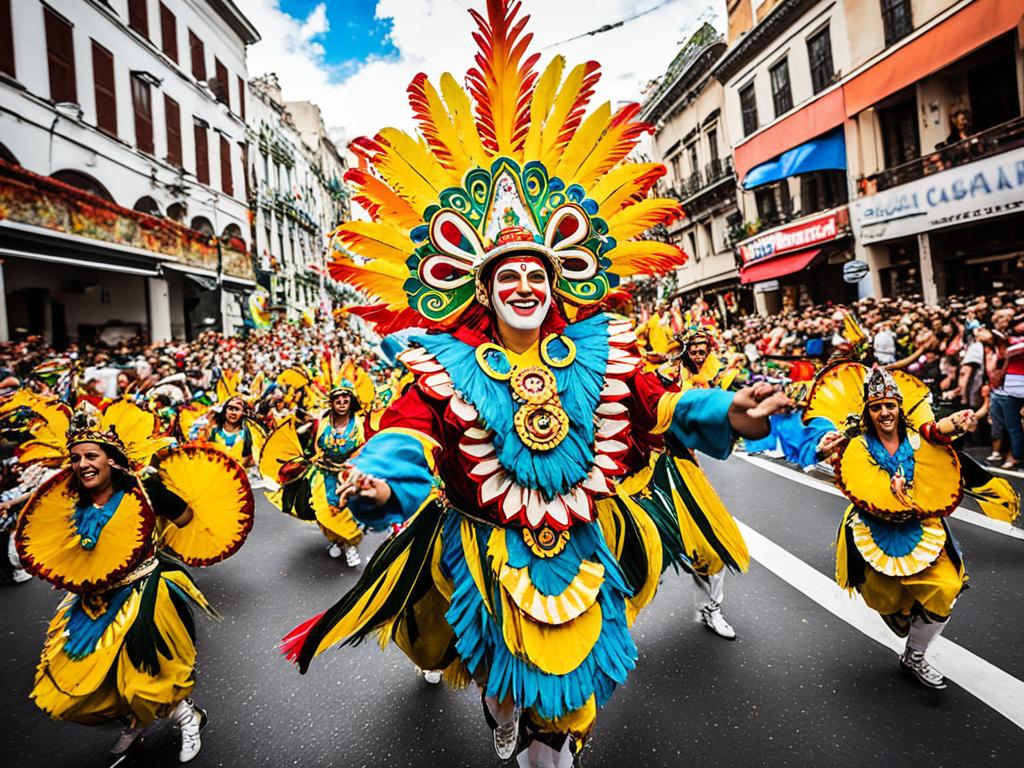Welcome to a visual journey around the world, where we will immerse ourselves in the vibrant and diverse world of cultural festivals. From the enchanting lantern festivals of Asia to the rhythmic beats of Caribbean carnivals, these celebrations offer a window into the traditions and artistry of different cultures. Join us as we explore the rich tapestry of global festivals that bring communities together and celebrate the beauty of our shared humanity.
Key Takeaways:
- Cultural festivals showcase the rich traditions and artistry of various cultures from around the world.
- These celebrations promote intercultural understanding by bringing people from different backgrounds together.
- Art, performance, and traditional crafts play a central role in cultural festivals, conveying stories and traditions.
- Modern festivals blend traditional elements with contemporary influences, attracting diverse audiences.
- Cultural festivals have a significant impact on tourism and economic growth, benefiting local economies.
The Importance of Cultural Festivals
Cultural festivals serve as a vital link between the past, present, and future, carrying the legacy of traditions and customs for generations to come. These celebrations hold immense importance in preserving and promoting cultural heritage, showcasing the rich tapestry of human diversity. Through vibrant displays of art, music, dance, and cuisine, cultural festivals create a platform for communities to express their unique identities and values.
At the heart of these festivals lies the celebration of traditions that have been passed down through time. From ancient rituals to modern interpretations, the importance of cultural festivals lies in their ability to connect individuals with their roots, providing a sense of belonging and pride. Participants actively engage in cultural celebrations, donning traditional attire, partaking in sacred customs, and sharing stories that honor the legacy of their ancestors.
One of the remarkable aspects of cultural festivals is their ability to foster intercultural understanding and promote unity. These celebrations bring together people from different backgrounds, showcasing the beauty of diversity. Through cultural exchanges, individuals gain insight into the values, beliefs, and customs of others, allowing for mutual respect and appreciation.
“Cultural festivals have the power to transcend boundaries, creating bridges that connect individuals from different walks of life.”
By embracing diverse cultural celebrations, we promote inclusivity and strengthen social cohesion. These festivals become a platform for dialogue and learning, encouraging people to engage in open conversations about their cultural heritage.
Moreover, cultural festivals contribute to the growth of local economies and tourism. As visitors are drawn to these vibrant celebrations, they provide opportunities for communities to showcase their traditional arts and crafts, local cuisines, and unique cultural experiences. This influx of tourism fosters economic growth, creating employment opportunities and supporting local businesses.
From the colorful parades of Mardi Gras to the mesmerizing dances of Diwali, cultural festivals captivate the senses and leave a lasting impression. These celebrations remind us of our shared humanity, bridging gaps between different cultures, and celebrating the rich tapestry of human heritage. The preservation and celebration of cultural festivals are not just traditions; they are a testament to the importance of upholding our collective identity and fostering connections that reach across borders and generations.
Celebrating Cultural Diversity: A Snapshot
Here’s a glimpse into a few cultural festivals from around the world:
| Festival Name | Country | Date | Significance |
|---|---|---|---|
| Oktoberfest | Germany | Late September to the first Sunday in October | Celebration of Bavarian culture, beer, and traditional music |
| Día de los Muertos (Day of the Dead) | Mexico | October 31 – November 2 | Honoring and remembering deceased loved ones |
| Chinese New Year | China | Varies (Lunar New Year) | Welcoming the arrival of a new year with grand celebrations |
| Diwali | India | Varies (October or November) | Festival of lights symbolizing the victory of light over darkness |
| Carnival | Brazil | 40 days before Easter (February or March) | Colorful parade and street parties before the Lenten season |
Iconic Festivals: A Journey Through Colors and Traditions
Embark on a virtual journey and immerse yourself in the vibrant tapestry of iconic festivals from around the world. These celebrations are renowned for their breathtaking visuals, rich cultural traditions, and vibrant atmosphere. Explore the origins, customs, and significance of these awe-inspiring events that showcase the diverse and colorful tapestry of human culture.
Holi Festival – India
One of the most renowned and vibrant festivals in India, Holi is a celebration of colors and joy. Held during the arrival of spring, this festival is a spectacle of vibrant powders and waters, symbolizing the victory of good over evil and the arrival of a new season. Participants playfully drench each other in colorful powders, dance to traditional music, and indulge in delicious sweets and treats.
Carnival – Brazil
Brazil’s Carnival is a mesmerizing extravaganza that captivates millions of people around the world. This dazzling festival is a showcase of elaborate costumes, samba parades, and electrifying energy. The streets come alive with samba rhythms, vibrant floats, and synchronized dancing. Carnival is a joyous celebration of Brazilian culture and a testament to the country’s rich history and heritage.
| Festival | Country | Date |
|---|---|---|
| Holi Festival | India | March |
| Carnival | Brazil | February |
The Holi Festival and Carnival are just two examples of the numerous iconic festivals celebrated worldwide. These vibrant celebrations not only bring communities together but also showcase the unique cultural traditions and customs that have been passed down through generations. From the electric atmosphere of La Tomatina in Spain to the illuminated lanterns of the Yi Peng Festival in Thailand, each festival offers an immersive experience into the heart of a particular culture.
Experience the magic of these iconic festivals and witness the incredible fusion of colors, traditions, and joy that permeates through these vibrant celebrations. Celebrate diversity, broaden your horizons, and create unforgettable memories as you partake in these extraordinary cultural experiences.
Art and Performance: The Heart of Cultural Celebrations
Dive into the artistic side of cultural festivals, where traditional crafts, music, and dance take center stage. These vibrant celebrations are a feast for the senses, showcasing the rich cultural heritage and artistic prowess of different communities around the world. From intricate costumes to rhythmic beats and mesmerizing movements, these art forms not only entertain but also convey stories and traditions passed down through generations.
One of the most visually striking aspects of cultural festivals is the use of traditional crafts. Craftsmanship is showcased through elaborate costumes, masks, and props that adorn the performers. These exquisite creations reflect the unique cultural identity of the community and often require meticulous attention to detail. For example, during the Chinese New Year, you can witness the remarkable artistry of the Lion Dance costumes, with their vibrant colors and intricate embroidery.
“Traditional crafts are the threads that connect the past, present, and future of a culture. They are the tangible expressions of a community’s values, traditions, and artistic legacy.” – Artisan Craft Magazine
Music is another integral part of cultural festivals, filling the air with melodies that transport you to another world. Whether it’s the hypnotic beats of African drumming, the soul-stirring sounds of traditional Japanese instruments, or the rhythmic chants of indigenous tribes, music plays a pivotal role in creating an immersive and enchanting experience.
Dance, too, takes center stage during these celebrations, with performers captivating audiences with their graceful movements and expressions. Traditional folk dances are an embodiment of a community’s history and beliefs, telling stories through fluid choreography and symbolic gestures. From the lively Flamenco in Spain to the elegant Odissi in India, each dance form carries its own cultural significance and leaves an indelible impression on those who witness it.
Discover the Artistic Tapestry of Cultural Festivals
Immerse yourself in the world of art and performance at some of the most renowned cultural festivals around the world:
- The Venice Carnival in Italy: Known for its opulent masks and costumes, this festival is a celebration of extravagance, creativity, and artistic expression.
- The Diwali Festival in India: This Festival of Lights features elaborate Rangoli designs, intricate clay lamps, and vibrant firework displays that illuminate the night sky.
- The Inti Raymi Festival in Peru: A colorful celebration of the Inca sun god, this festival showcases vibrant costumes, traditional music, and spirited dances that pay homage to ancient traditions.
| Cultural Festival | Country | Artistic Highlights |
|---|---|---|
| Chinese New Year | China | Intricate lion dance costumes adorned with vibrant colors and ornate embroidery |
| Notting Hill Carnival | United Kingdom | Elaborate Caribbean-inspired costumes with vibrant feathers and sequins |
| Diwali Festival | India | Colorful Rangoli designs created using colored powders and petals |
| Celebration of Light | Canada | Firework displays synchronized with music, creating visually stunning spectacles |
Experience the magic of cultural festivals where art and performance come together, echoing the spirit and creativity of diverse cultures. Celebrate the beauty of traditional crafts, immerse yourself in mesmerizing music, and witness the captivating artistry of dance. These festivals are windows into the rich tapestry of global traditions, inviting you to explore and appreciate the world’s cultural heritage.
The Evolution of Cultural Festivals
Cultural festivals have always been a reflection of the societies in which they originate. As social, political, and technological landscapes shift, these festivals have evolved, embracing modern influences while preserving their rich traditions. Today, modern festivals offer a fusion of cultural elements that appeal to both locals and tourists, creating unique and immersive experiences.
One of the most notable aspects of the evolution of cultural festivals is the incorporation of contemporary elements into traditional celebrations. Music festivals, for example, have become a platform for showcasing cultural diversity while highlighting modern music genres. Artists from different cultural backgrounds come together to create a harmonious blend of traditional melodies and contemporary beats, captivating audiences with their mesmerizing performances.
Modern festivals go beyond traditional boundaries, offering a platform for cultural fusion and creative collaboration.
In addition to music festivals, culinary events have also embraced the evolution of cultural festivals. Food has always been a powerful expression of culture, and modern festivals have taken this art form to new heights. From street food festivals that bring together diverse cuisines to culinary competitions that highlight traditional cooking techniques, these events celebrate the flavors and diversity of cultures from around the world.
Cultural fusion is not limited to performances and cuisine; it extends to visual arts as well.
The visual arts have also played a significant role in the evolution of cultural festivals. Contemporary art exhibitions that combine traditional art forms with modern interpretations have gained immense popularity. These exhibitions provide a platform for artists to experiment with new mediums and techniques while staying rooted in their cultural heritage.
As cultural festivals continue to evolve, they attract diverse audiences from across the globe. These festivals have transformed into multicultural celebrations that bridge the gap between different communities, fostering cultural understanding and appreciation.
The evolution of cultural festivals is an ongoing process, driven by the desire to preserve traditions while embracing the modern world.
Through modern festivals, cultural fusion becomes a channel for promoting dialogue, forging connections, and celebrating the rich tapestry of human cultures.
The Impact of Technology on the Evolution of Cultural Festivals
Technology has played a pivotal role in shaping the evolution of cultural festivals. From online platforms that promote and facilitate festival attendance to immersive experiences enhanced by virtual reality and augmented reality, technology has revolutionized the way we experience and engage with cultural celebrations.
Virtual tours and livestreaming have enabled people from all corners of the world to participate in cultural festivals, breaking down geographical barriers and fostering a global sense of community. Through these digital platforms, individuals can experience the sights, sounds, and cultural nuances of festivals they may not have the opportunity to attend in person.
“Technology has provided us with new tools to preserve, promote, and experience cultural festivals in ways that were unimaginable in the past.”
Furthermore, technology has allowed festival organizers to enhance the visitor experience by incorporating interactive elements. Augmented reality (AR) and virtual reality (VR) experiences enable attendees to immerse themselves in the rich history and traditions associated with cultural festivals. These cutting-edge technologies bring cultural celebrations to life, creating immersive and memorable experiences for participants.
Preserving Tradition in a Modern World
While cultural festivals have evolved to embrace modern influences, preserving tradition remains a cornerstone of these celebrations. Many festival organizers strive to strike a balance between incorporating contemporary elements and staying true to their cultural roots.
By combining old and new, cultural festivals create a dynamic and ever-evolving experience for participants. They become a living testament to the resilience and adaptability of cultural traditions, ensuring their survival and continued celebration in the modern world.
As cultural festivals continue to evolve, it is essential to recognize the transformative power they hold. These celebrations serve as a powerful medium for cultural exchange, fostering appreciation and understanding among diverse communities.
With each passing year, cultural festivals will undoubtedly undergo further transformations, adapting to the ever-changing world while honoring the legacy of centuries-old traditions. The evolution of cultural festivals is an ongoing story, weaving together the threads of past, present, and future.
Cultural Festivals: A Catalyst for Tourism and Economic Growth
Cultural festivals have become significant drivers of tourism and economic growth for many destinations. These vibrant celebrations attract millions of visitors each year, eager to immerse themselves in the rich traditions and cultural experiences that these festivals offer. The profound impact of cultural festivals can be seen in four key areas: increased visitor spending, job creation, infrastructure development, and the enhancement of a destination’s reputation as a cultural hub.
Increased Visitor Spending
When cultural festivals take place, they draw in a large influx of domestic and international tourists. These visitors not only spend money on accommodations, transportation, and food but also engage in various cultural activities and purchase local goods and crafts. This surge in visitor spending provides a significant boost to the local economy, supporting businesses and creating new opportunities for entrepreneurs.
Job Creation
Cultural festivals generate employment opportunities within the tourism industry. From event planning and management to hospitality services and retail, festivals create a demand for a diverse range of job roles. This job creation stimulates economic growth, reduces unemployment rates, and improves the overall livelihood of the local population.
Infrastructure Development
To accommodate the growing number of tourists attracted by cultural festivals, destinations often invest in infrastructure development. This includes the construction or renovation of hotels, transportation systems, cultural venues, and recreational facilities. The improved infrastructure not only enhances the visitor experience but also benefits the local community in the long run, attracting more tourists and sustained economic growth.
Enhanced Destination Reputation
Hosting culturally significant festivals elevates a destination’s reputation as a cultural hub. Countries and cities that are known for their vibrant celebrations and diverse cultural experiences often gain international recognition and become sought-after travel destinations. This increased visibility attracts tourists from around the world, further bolstering the local economy and establishing the destination as a cultural and tourism hotspot.
“Cultural festivals have the power to transform destinations into thriving cultural and economic centers. They showcase the unique traditions and heritage of a place, while also creating opportunities for economic growth and community development.” – Dr. Emma Thompson, Cultural Anthropologist
Overall, cultural festivals have a profound impact on tourism and economic growth. They not only bring communities together but also attract tourists, stimulate local businesses, and improve infrastructure. These festivals serve as gateways to explore different cultures, promote intercultural understanding, and contribute to the sustainable development of destinations.
| Positive Impacts of Cultural Festivals | Examples |
|---|---|
| Increased Visitor Spending | Notting Hill Carnival in London, England |
| Job Creation | Burning Man Festival in Nevada, USA |
| Infrastructure Development | Chinese New Year Parade in San Francisco, USA |
| Enhanced Destination Reputation | La Tomatina in Buñol, Spain |
Conclusion
After embarking on this visual journey through cultural festivals around the world, you have witnessed the power of these celebrations to unite communities, preserve traditions, and promote cultural diversity. From ancient rituals to modern spectacles, cultural festivals are a testament to the beauty and resilience of human culture.
These festivals not only showcase the unique customs and artistry of different cultures but also foster a sense of pride and identity among participants. They provide a platform for communities to come together, celebrate their heritage, and share their traditions with the world. Cultural festivals promote intercultural understanding, allowing people from diverse backgrounds to appreciate and learn from one another’s customs and beliefs.
Plan your own cultural festival adventure and immerse yourself in the vibrant tapestry of global traditions. From witnessing the magnificent parades at Carnival in Rio de Janeiro to exploring the captivating lantern festivals in Thailand, there is a world of cultural experiences waiting to be discovered. So embrace the magic, the music, the colors, and the flavors of cultural festivals and embark on an unforgettable journey that will broaden your horizons and deepen your appreciation for the rich tapestry of human heritage.







